 Advances in Chemical Engi neering and Science , 2011, 1, 271-279 doi:10.4236/aces.2011.14038 Published Online October 2011 (http://www.SciRP.org/journal/aces) Copyright © 2011 SciRes. ACES Non-Isoth e rma l S epa rat ion Process of Two-Phase Mixture Water/Ultra-Viscous Heavy Oil by Hydr ocyclone Josedite Saraiva de Souza1, Fabiana Pimentel Macêdo Farias2, Ramdayal Swarnakar1, Severino Rodrigues de Farias Neto1, Antonio Gilson Barbos de Lima3 1Department of Chemical Engineering, Center of Sciences and Technology, Federal University of Campina Grande, Campina Grande, Paraíba, Brazil 2Department of Technology and Development, Center for Sustainable Development of the Semi-Arid (CDSA), Federal University of Campina Grande, Sumé, Paraíba, Brazil 3Department of Mechanical Engineering, Center of Sciences and Technology, Federal University of Campina Grande, Campina Grande, Paraíba, Brazil E-mail: eng.josedite@hotmail.com, fariasn@deq.ufcg.edu.br, rdswarnakar@yahoo.com, fabianapmf@m sn.com, gilson@dem.ufcg.edu.br Recieved July 6, 2011; revised July 20, 2011; accepted July 30, 2011 Abstract Environmental agencies do not allow effluents, from the petroleum productions, which contain oil concen- trations that exceed the amounts permitted by the regulations. In recent time heavy oil operating petroleum industries are generating oil/water mixture by products, which are difficult to separate. Industrially, hydro- cyclone is generally used to separate oil from an oil/water mixture. This is due to its high performance of separation, low cost of installation and maintenance. In the present work, therefore, the thermal fluid dy- namics of water/ultra-viscous heavy oil separation process in a hydrocyclone has been studied. A steady state mathematical model which simulates the performance of a non-isothermal separation process is presented. The Eulerian-Eulerian approach for the interface of the phases involved (water/ultra-viscous heavy-oil) is used and the two-phase flow is considered as incompressible, viscous and turbulent. For carrying out nu- merical solutions of the governing equations the CFX11® commercial code was used. Results of the behavior of the two-fluid flow inside the hydrocyclone and separation efficiency are presented and analyzed. The role of the average temperature of the fluid, oil droplet diameter and the fluid mixture inlet velocity on the sepa- ration efficiency of the hydrocyclone are verified. Keywords: Thermal Fluid Dynamics, Hydrocyclone, Two-Phase Flow, Simulation, Separation Efficiency 1. Introduction Petroleum industry has produced a large quantity of wa- ter along with hydrocarbons from oil and gas fields all over the world. The produced water comes as a byprod- uct of petroleum production and requires to be separated efficiently. On offshore platforms, produced water can be discharged directly into the ocean provided the dispersed phase concentration of oil and grease is below a specified value, such as 29 ppm in the Gulf of Mexico and 20 ppm in Brazil. In Norway, the oil operators have agreed to implement a policy of zero harmful discharges in the environment. A number of studies have been found in literature us- ing cyclones or hydrocyclones in the two-phase separa- tion processes [1-4]. Hydrocyclones have been used for over a hundred years by chemical process industries. However, just from the 60's there has been an increase of its application in various other fields of technology and is, therefore, considered an equipment of great importance for separation processes. This has happened in virtue of its high processing capacity, less physical space needed for its installations, easiness of operation and cheaper maintenance. In this context, some important experi- mental results of field trial of a patented CANMET hy- drocyclone have been reported [5]. Their hydrocyclone was designed to process the difficult-to-separate oily fluids which were generated by heavy oil operations in western Canada. Despite the advantages and simplicity, the fluid dy- 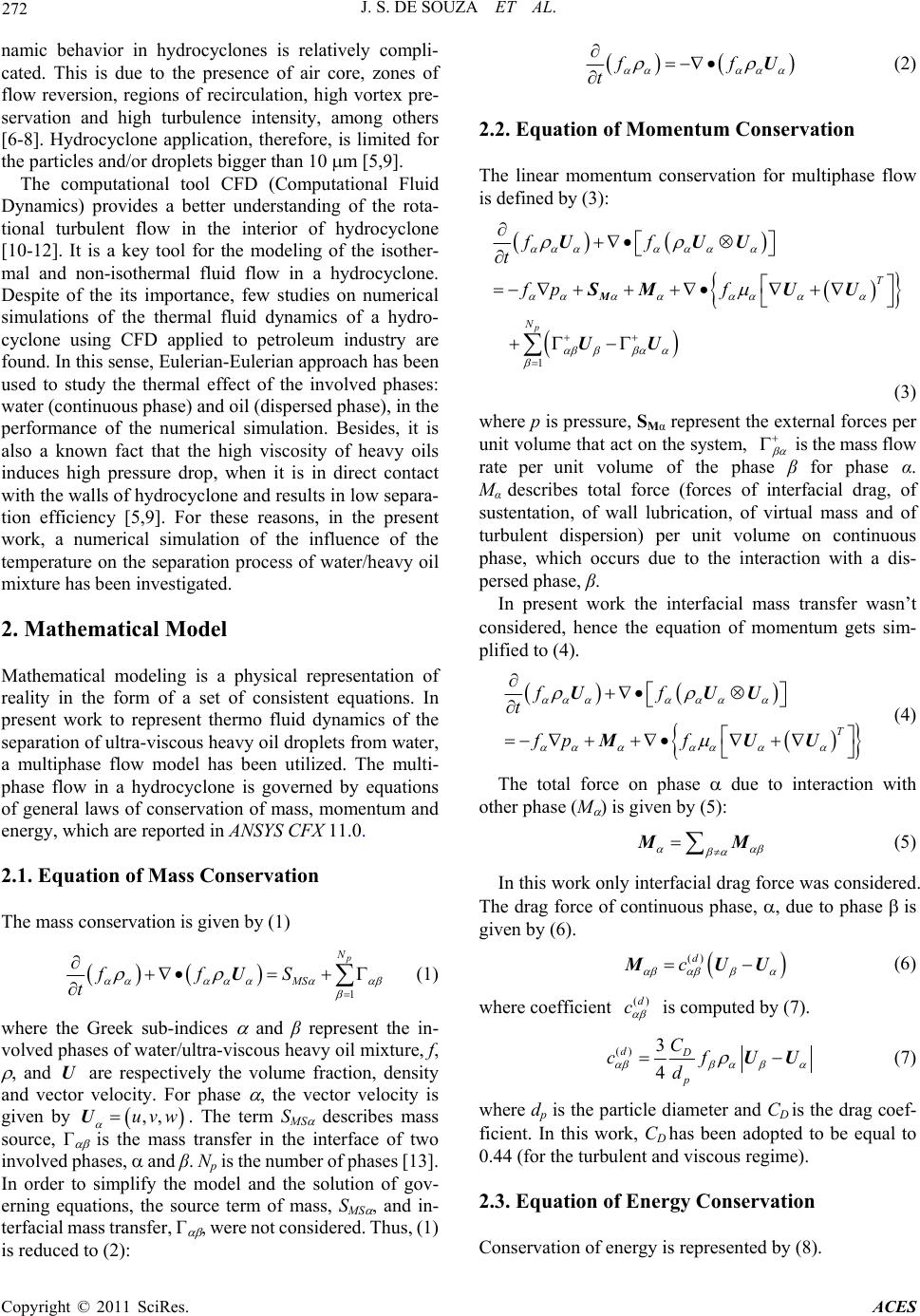 272 J. S. DE SOUZA ET AL. namic behavior in hydrocyclones is relatively compli- cated. This is due to the presence of air core, zones of flow reversion, regions of recirculation, high vortex pre- servation and high turbulence intensity, among others [6-8]. Hydrocyclone application, therefore, is limited for the particles and/or droplets bigger than 10 m [5,9]. The computational tool CFD (Computational Fluid Dynamics) provides a better understanding of the rota- tional turbulent flow in the interior of hydrocyclone [10-12]. It is a key tool for the modeling of the isother- mal and non-isothermal fluid flow in a hydrocyclone. Despite of the its importance, few studies on numerical simulations of the thermal fluid dynamics of a hydro- cyclone using CFD applied to petroleum industry are found. In this sense, Eulerian-Eulerian approach has been used to study the thermal effect of the involved phases: water (continuous phase) and oil (dispersed phase), in the performance of the numerical simulation. Besides, it is also a known fact that the high viscosity of heavy oils induces high pressure drop, when it is in direct contact with the walls of hydrocyclone and results in low separa- tion efficiency [5,9]. For these reasons, in the present work, a numerical simulation of the influence of the temperature on the separation process of water/heavy oil mixture has been investigated. 2. Mathematical Model Mathematical modeling is a physical representation of reality in the form of a set of consistent equations. In present work to represent thermo fluid dynamics of the separation of ultra-viscous heavy oil droplets from water, a multiphase flow model has been utilized. The multi- phase flow in a hydrocyclone is governed by equations of general laws of conservation of mass, momentum and energy, which are reported in ANSYS CFX 11.0. 2.1. Equation of Mass Conservation The mass conservation is given by (1) 1 p N MS ffS t U (1) where the Greek sub-indices and β represent the in- volved phases of water/ultra-viscous heavy oil mixture, f, , and are respectively the volume fraction, density and vector velocity. For phase , the vector velocity is given by . The term SMS describes mass source, Г is the mass transfer in the interface of two involved phases, and β. Np is the number of phases [13]. In order to simplify the model and the solution of gov- erning equations, the source term of mass, SMS , and in- terfacial mass transfer, Г , were not considered. Thus, (1) is reduced to (2): U U ,,uvw ff t U (2) 2.2. Equation of Momentum Conservation The linear momentum conservation for multiphase flow is defined by (3): 1 p T N ff t fp f M UUU SMU U UU (3) where p is pressure, SMα represent the external forces per unit volume that act on the system, is the mass flow rate per unit volume of the phase β for phase α. Mα describes total force (forces of interfacial drag, of sustentation, of wall lubrication, of virtual mass and of turbulent dispersion) per unit volume on continuous phase, which occurs due to the interaction with a dis- persed phase, β. In present work the interfacial mass transfer wasn’t considered, hence the equation of momentum gets sim- plified to (4). T ff t fp f UUU MUU (4) The total force on phase due to interaction with other phase (M ) is given by (5): MM (5) In this work only interfacial drag force was considered. The drag force of continuous phase, , due to phase is given by (6). ()d c MUU (6) where coefficient ()d c is computed by (7). () 3 4 dD p C cf d UU (7) where dp is the particle diameter and CD is the drag coef- ficient. In this work, CD has been adopted to be equal to 0.44 (for the turbulent and viscous regime). 2.3. Equation of Energy Conservation Conservation of energy is represented by (8). Copyright © 2011 SciRes. ACES 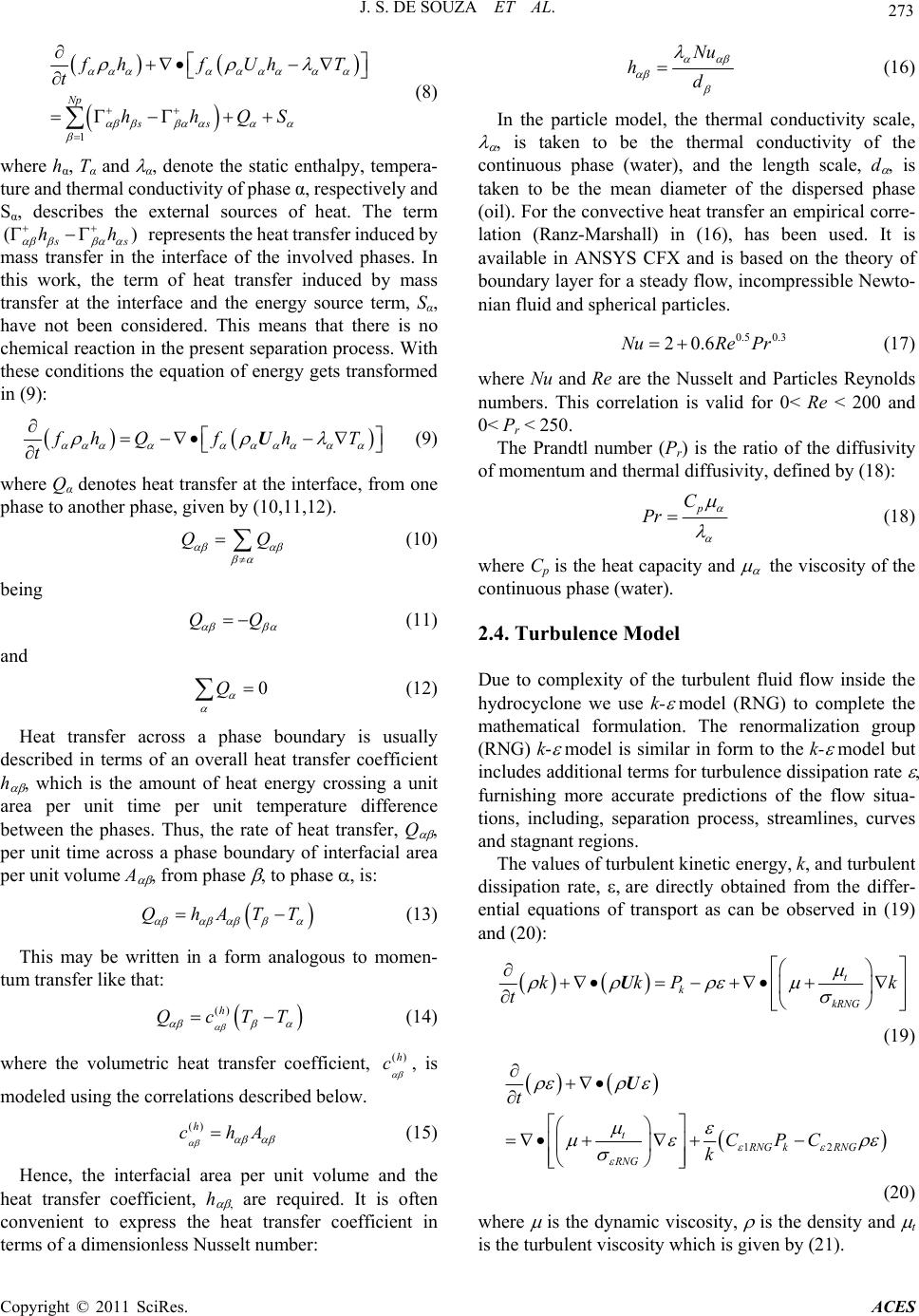 J. S. DE SOUZA ET AL. 273 1 Np ss fhf UhT t hhQS ) (8) where hα, Tα and α, denote the static enthalpy, tempera- ture and thermal conductivity of phase α, respectively and Sα, describes the external sources of heat. The term ( s hh represents the heat transfer induced by mass transfer in the interface of the involved phases. In this work, the term of heat transfer induced by mass transfer at the interface and the energy source term, Sα, have not been considered. This means that there is no chemical reaction in the present separation process. With these conditions the equation of energy gets transformed in (9): fh QfhT t U (9) where Qα denotes heat transfer at the interface, from one phase to another phase, given by (10,11,12). QQ (10) being QQ (11) and 0 Q (12) Heat transfer across a phase boundary is usually described in terms of an overall heat transfer coefficient h , which is the amount of heat energy crossing a unit area per unit time per unit temperature difference between the phases. Thus, the rate of heat transfer, Q , per unit time across a phase boundary of interfacial area per unit volume A , from phase to phase , is: QhATT (13) This may be written in a form analogous to momen- tum transfer like that: () h QcTT (14) where the volumetric heat transfer coefficient, ()h c , is modeled using the correlations described below. () h chA (15) Hence, the interfacial area per unit volume and the heat transfer coefficient, h are required. It is often convenient to express the heat transfer coefficient in terms of a dimensionless Nusselt number: Nu hd (16) In the particle model, the thermal conductivity scale, is taken to be the thermal conductivity of the continuous phase (water), and the length scale, d is taken to be the mean diameter of the dispersed phase (oil). For the convective heat transfer an empirical corre- lation (Ranz-Marshall) in (16), has been used. It is available in ANSYS CFX and is based on the theory of boundary layer for a steady flow, incompressible Newto- nian fluid and spherical particles. 0.5 0.3 20.6NuRe Pr (17) where Nu and Re are the Nusselt and Particles Reynolds numbers. This correlation is valid for 0< Re < 200 and 0< Pr < 250. The Prandtl number (Pr) is the ratio of the diffusivity of momentum and thermal diffusivity, defined by (18): p C Pr (18) where Cp is the heat capacity and the viscosity of the continuous phase (water). 2.4. Turbulence Model Due to complexity of the turbulent fluid flow inside the hydrocyclone we use k- model (RNG) to complete the mathematical formulation. The renormalization group (RNG) k- model is similar in form to the k- model but includes additional terms for turbulence dissipation rate , furnishing more accurate predictions of the flow situa- tions, including, separation process, streamlines, curves and stagnant regions. The values of turbulent kinetic energy, k, and turbulent dissipation rate, are directly obtained from the differ- ential equations of transport as can be observed in (19) and (20): t k kRNG kkP t k U (19) 12 t RNG kRNG RNG t CPC k U (20) where is the dynamic viscosity, is the density and t is the turbulent viscosity which is given by (21). Copyright © 2011 SciRes. ACES 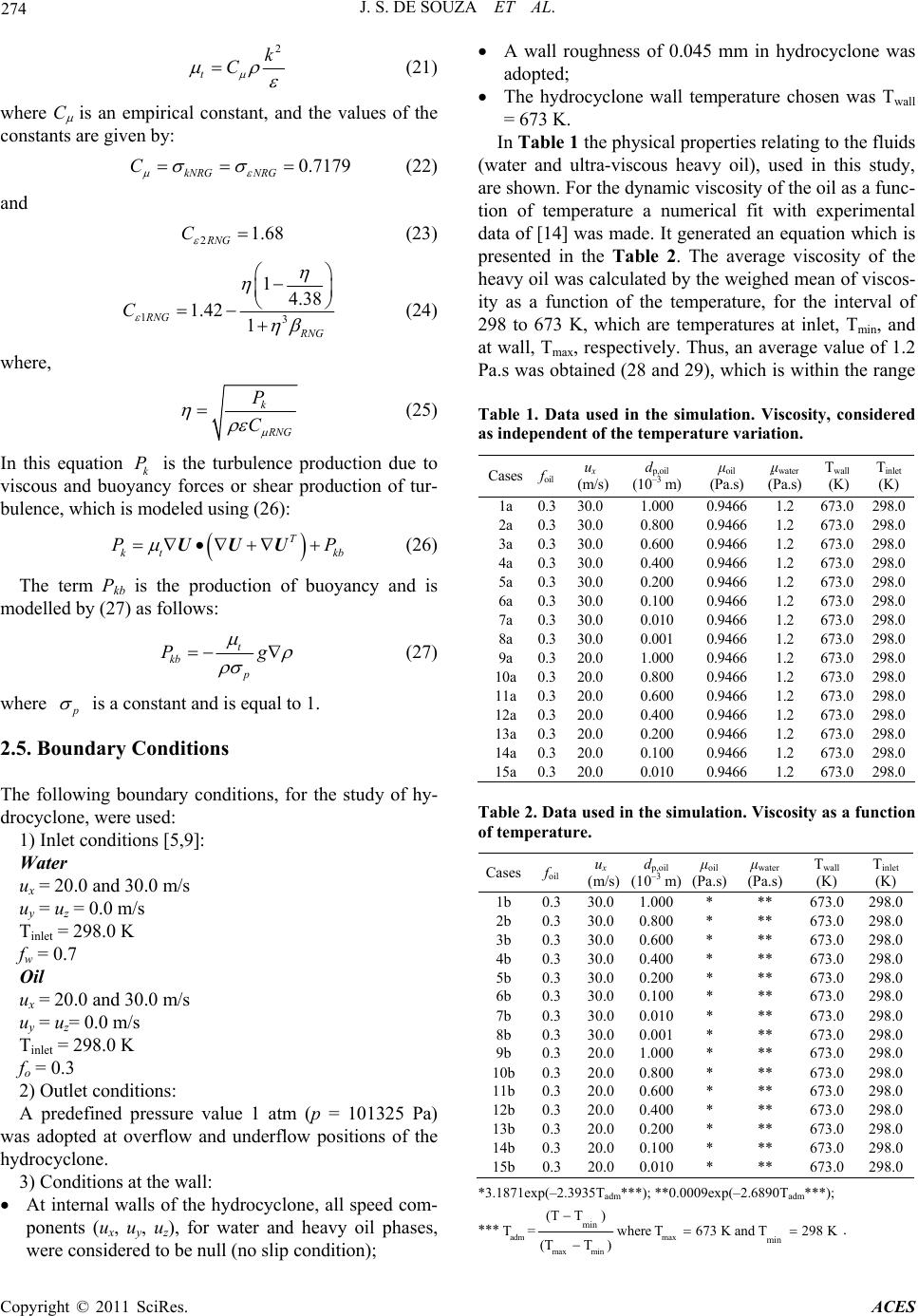 274 J. S. DE SOUZA ET AL. 2 t k C (21) where C is an empirical constant, and the values of the constants are given by: 0.7179 kNRG NRG C (22) and 21.68 RNG C (23) 13 14.38 1.42 1 RNG RNG C (24) where, k NG P C (25) In this equation k is the turbulence production due to viscous and buoyancy forces or shear production of tur- bulence, which is modeled using (26): P T kt k PP UUU b (26) The term Pkb is the production of buoyancy and is modelled by (27) as follows: t kb p P g (27) where is a constant and is equal to 1. 2.5. Boundary Conditions The following boundary conditions, for the study of hy- drocyclone, were used: 1) Inlet conditions [5,9]: Water ux = 20.0 and 30.0 m/s uy = uz = 0.0 m/s Tinlet = 298.0 K fw = 0.7 Oil ux = 20.0 and 30.0 m/s uy = uz= 0.0 m/s Tinlet = 298.0 K fo = 0.3 2) Outlet conditions: A predefined pressure value 1 atm (p = 101325 Pa) was adopted at overflow and underflow positions of the hydrocyclone. 3) Conditions at the wall: At internal walls of the hydrocyclone, all speed com- ponents (ux, u y, u z), for water and heavy oil phases, were considered to be null (no slip condition); A wall roughness of 0.045 mm in hydrocyclone was adopted; The hydrocyclone wall temperature chosen was Twall = 673 K. In Tab le 1 the physical properties relating to the fluids (water and ultra-viscous heavy oil), used in this study, are shown. For the dynamic viscosity of the oil as a func- tion of temperature a numerical fit with experimental data of [14] was made. It generated an equation which is presented in the Table 2. The average viscosity of the heavy oil was calculated by the weighed mean of viscos- ity as a function of the temperature, for the interval of 298 to 673 K, which are temperatures at inlet, Tmin, and at wall, Tmax, respectively. Thus, an average value of 1.2 Pa.s was obtained (28 and 29), which is within the range Table 1. Data used in the simulation. Viscosity, considered as independent of the temper atur e variation. Cases foil ux (m/s) dp,oil (10–3 m) μoil (Pa.s) μwater (Pa.s) Twall (K) Tinlet (K) 1a 0.330.0 1.000 0.9466 1.2 673.0298.0 2a 0.330.0 0.800 0.9466 1.2 673.0298.0 3a 0.330.0 0.600 0.9466 1.2 673.0298.0 4a 0.330.0 0.400 0.9466 1.2 673.0298.0 5a 0.330.0 0.200 0.9466 1.2 673.0298.0 6a 0.330.0 0.100 0.9466 1.2 673.0298.0 7a 0.330.0 0.010 0.9466 1.2 673.0298.0 8a 0.330.0 0.001 0.9466 1.2 673.0298.0 9a 0.320.0 1.000 0.9466 1.2 673.0298.0 10a 0.3 20.0 0.800 0.9466 1.2 673.0298.0 11a 0.3 20.0 0.600 0.9466 1.2 673.0298.0 12a 0.3 20.0 0.400 0.9466 1.2 673.0298.0 13a 0.3 20.0 0.200 0.9466 1.2 673.0298.0 14a 0.3 20.0 0.100 0.9466 1.2 673.0298.0 15a 0.3 20.0 0.010 0.9466 1.2 673.0298.0 Table 2. Data used in the simulation. Viscosity as a function of temperature. Cases foil ux (m/s) dp,oil (10–3 m) μoil (Pa.s) μwat er (Pa.s) Twall (K) Tinlet (K) 1b 0.330.01.000* ** 673.0298.0 2b 0.330.00.800* ** 673.0298.0 3b 0.330.00.600* ** 673.0298.0 4b 0.330.00.400* ** 673.0298.0 5b 0.330.00.200* ** 673.0298.0 6b 0.330.00.100* ** 673.0298.0 7b 0.330.00.010* ** 673.0298.0 8b 0.330.00.001* ** 673.0298.0 9b 0.320.01.000* ** 673.0298.0 10b0.320.00.800* ** 673.0298.0 11b0.320.00.600* ** 673.0298.0 12b0.320.00.400* ** 673.0298.0 13b0.320.00.200* ** 673.0298.0 14b0.320.00.100* ** 673.0298.0 15b0.320.00.010* ** 673.0298.0 *3.1871 exp(–2.3 935Tadm***); **0.0009exp(–2.6890Tadm***); *** adm max max min min min (T T) T=whereT673 K andT298 K (TT) . Copyright © 2011 SciRes. ACES 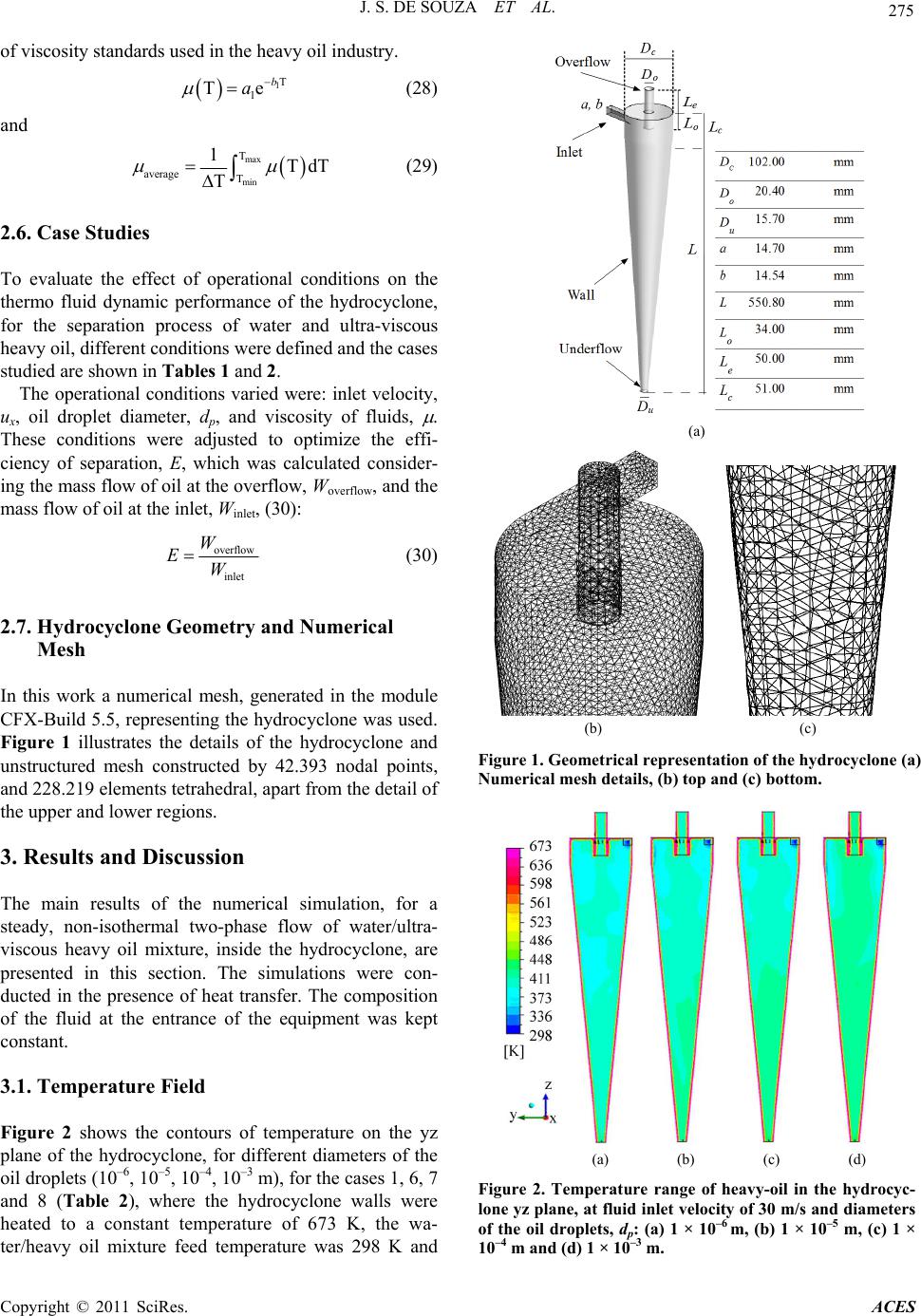 J. S. DE SOUZA ET AL. 275 of viscosity standards used in the heavy oil industry. 1T 1 Te b a (28) and max min T average T 1TdT T (29) 2.6. Case Studies To evaluate the effect of operational conditions on the thermo fluid dynamic performance of the hydrocyclone, for the separation process of water and ultra-viscous heavy oil, different conditions were defined and the cases studied are shown in Tables 1 and 2. The operational conditions varied were: inlet velocity, ux, oil droplet diameter, dp, and viscosity of fluids, . These conditions were adjusted to optimize the effi- ciency of separation, E, which was calculated consider- ing the mass flow of oil at the overflow, Woverflow, and the mass flow of oil at the inlet, Winlet, (30): overflow inlet W EW (30) 2.7. Hydrocyclone Geometry and Numerical Mesh In this work a numerical mesh, generated in the module CFX-Build 5.5, representing the hydrocyclone was used. Figure 1 illustrates the details of the hydrocyclone and unstructured mesh constructed by 42.393 nodal points, and 228.219 elements tetrahedral, apart from the detail of the upper and lower regions. 3. Results and Discussion The main results of the numerical simulation, for a steady, non-isothermal two-phase flow of water/ultra- viscous heavy oil mixture, inside the hydrocyclone, are presented in this section. The simulations were con- ducted in the presence of heat transfer. The composition of the fluid at the entrance of the equipment was kept constant. 3.1. Temperature Field Figure 2 shows the contours of temperature on the yz plane of the hydrocyclone, for different diameters of the oil droplets (10–6, 10–5, 10–4, 10–3 m), for the cases 1, 6, 7 and 8 (Table 2), where the hydrocyclone walls were heated to a constant temperature of 673 K, the wa- ter/heavy oil mixture feed temperature was 298 K and (a) (b) (c) Figure 1. Geometrical representation of the hydrocyclone (a) Numerical mesh details, (b) top and (c) bottom. (a) (b) (c) (d) Figure 2. Temperature range of heavy-oil in the hydrocyc- lone yz plane, at fluid inlet velocity of 30 m/s and diameters of the oil droplets, dp: (a) 1 × 10–6 m, (b) 1 × 10–5 m, (c) 1 × 10–4 m and (d) 1 × 10–3 m. Copyright © 2011 SciRes. ACES 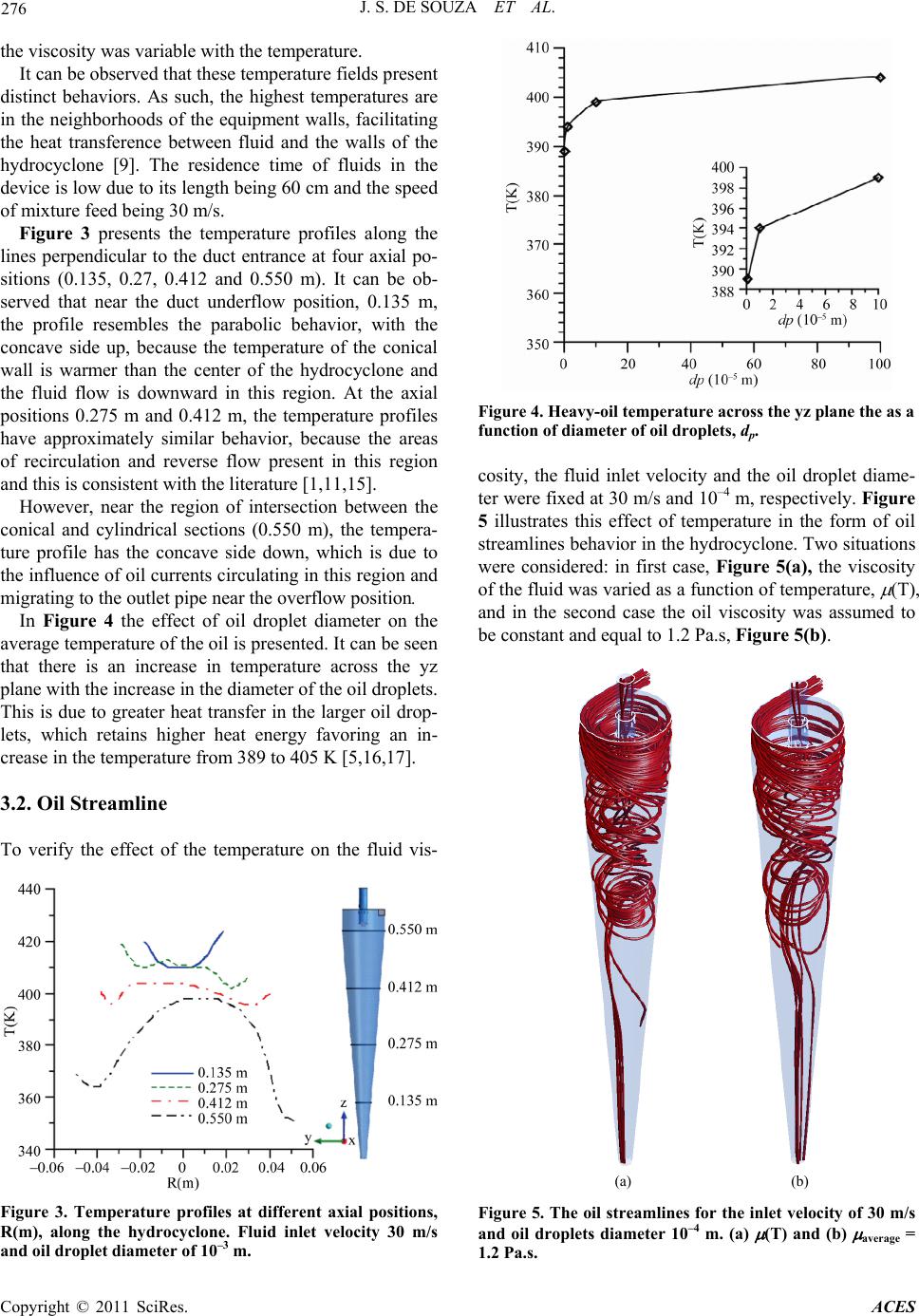 276 J. S. DE SOUZA ET AL. the viscosity was variable with the temperature. It can be observed that these temperature fields present distinct behaviors. As such, the highest temperatures are in the neighborhoods of the equipment walls, facilitating the heat transference between fluid and the walls of the hydrocyclone [9]. The residence time of fluids in the device is low due to its length being 60 cm and the speed of mixture feed being 30 m/s. Figure 3 presents the temperature profiles along the lines perpendicular to the duct entrance at four axial po- sitions (0.135, 0.27, 0.412 and 0.550 m). It can be ob- served that near the duct underflow position, 0.135 m, the profile resembles the parabolic behavior, with the concave side up, because the temperature of the conical wall is warmer than the center of the hydrocyclone and the fluid flow is downward in this region. At the axial positions 0.275 m and 0.412 m, the temperature profiles have approximately similar behavior, because the areas of recirculation and reverse flow present in this region and this is consistent with the literature [1,11,15]. However, near the region of intersection between the conical and cylindrical sections (0.550 m), the tempera- ture profile has the concave side down, which is due to the influence of oil currents circulating in this region and migrating to the outlet pipe near the overflow position. In Figure 4 the effect of oil droplet diameter on the average temperature of the oil is presented. It can be seen that there is an increase in temperature across the yz plane with the increase in the diameter of the oil droplets. This is due to greater heat transfer in the larger oil drop- lets, which retains higher heat energy favoring an in- crease in the temperature from 389 to 405 K [5,16,17]. 3.2. Oil Streamline To verify the effect of the temperature on the fluid vis- Figure 3. Temperature profiles at different axial positions, R(m), along the hydrocyclone. Fluid inlet velocity 30 m/s and oil droplet diameter of 10–3 m. Figure 4. Heavy-oil temperature across the yz plane the as a function of diameter of oil droplets, dp. cosity, the fluid inlet velocity and the oil droplet diame- ter were fixed at 30 m/s and 10–4 m, respectively. Figure 5 illustrates this effect of temperature in the form of oil streamlines behavior in the hydrocyclone. Two situations were considered: in first case, Figure 5(a), the viscosity of the fluid was varied as a function of temperature, (T), and in the second case the oil viscosity was assumed to be constant and equal to 1.2 Pa.s, Figure 5(b). (a) (b) Figure 5. The oil streamlines for the inlet velocity of 30 m/s and oil droplets diameter 10–4 m. (a) (T) and (b) average = 1.2 Pa.s. Copyright © 2011 SciRes. ACES 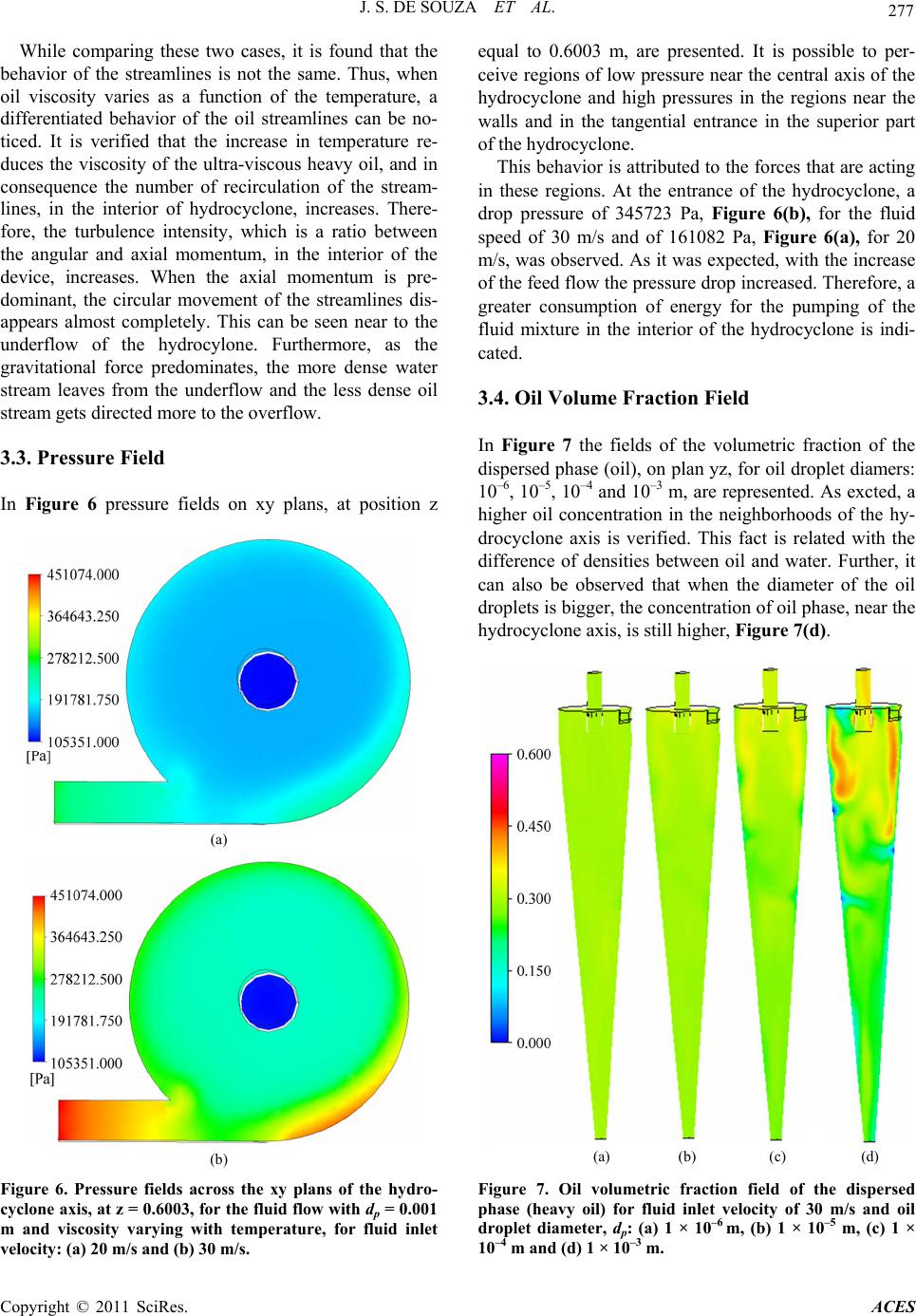 J. S. DE SOUZA ET AL. 277 While comparing these two cases, it is found that the behavior of the streamlines is not the same. Thus, when oil viscosity varies as a function of the temperature, a differentiated behavior of the oil streamlines can be no- ticed. It is verified that the increase in temperature re- duces the viscosity of the ultra-viscous heavy oil, and in consequence the number of recirculation of the stream- lines, in the interior of hydrocyclone, increases. There- fore, the turbulence intensity, which is a ratio between the angular and axial momentum, in the interior of the device, increases. When the axial momentum is pre- dominant, the circular movement of the streamlines dis- appears almost completely. This can be seen near to the underflow of the hydrocylone. Furthermore, as the gravitational force predominates, the more dense water stream leaves from the underflow and the less dense oil stream gets directed more to the overflow. 3.3. Pressure Field In Figure 6 pressure fields on xy plans, at position z (a) (b) Figure 6. Pressure fields across the xy plans of the hydro- cyclone axis, at z = 0.6003, for the fluid flow with dp = 0.001 m and viscosity varying with temperature, for fluid inlet velocity: (a) 20 m/s and (b) 30 m/s. equal to 0.6003 m, are presented. It is possible to per- ceive regions of low pressure near the central axis of the hydrocyclone and high pressures in the regions near the walls and in the tangential entrance in the superior part of the hydrocyclone. This behavior is attributed to the forces that are acting in these regions. At the entrance of the hydrocyclone, a drop pressure of 345723 Pa, Figure 6(b), for the fluid speed of 30 m/s and of 161082 Pa, Figure 6(a), for 20 m/s, was observed. As it was expected, with the increase of the feed flow the pressure drop increased. Therefore, a greater consumption of energy for the pumping of the fluid mixture in the interior of the hydrocyclone is indi- cated. 3.4. Oil Volume Fraction Field In Figure 7 the fields of the volumetric fraction of the dispersed phase (oil), on plan yz, for oil droplet diamers: 10–6, 10–5, 10–4 and 10–3 m, are represented. As excted, a higher oil concentration in the neighborhoods of the hy- drocyclone axis is verified. This fact is related with the difference of densities between oil and water. Further, it can also be observed that when the diameter of the oil droplets is bigger, the concentration of oil phase, near the hydrocyclone axis, is still higher, Figure 7(d). (a) (b) (c) (d) Figure 7. Oil volumetric fraction field of the dispersed phase (heavy oil) for fluid inlet velocity of 30 m/s and oil droplet diameter, dp: (a) 1 × 10–6 m, (b) 1 × 10–5 m, (c) 1 × 10–4 m and (d) 1 × 10–3 m. Copyright © 2011 SciRes. ACES 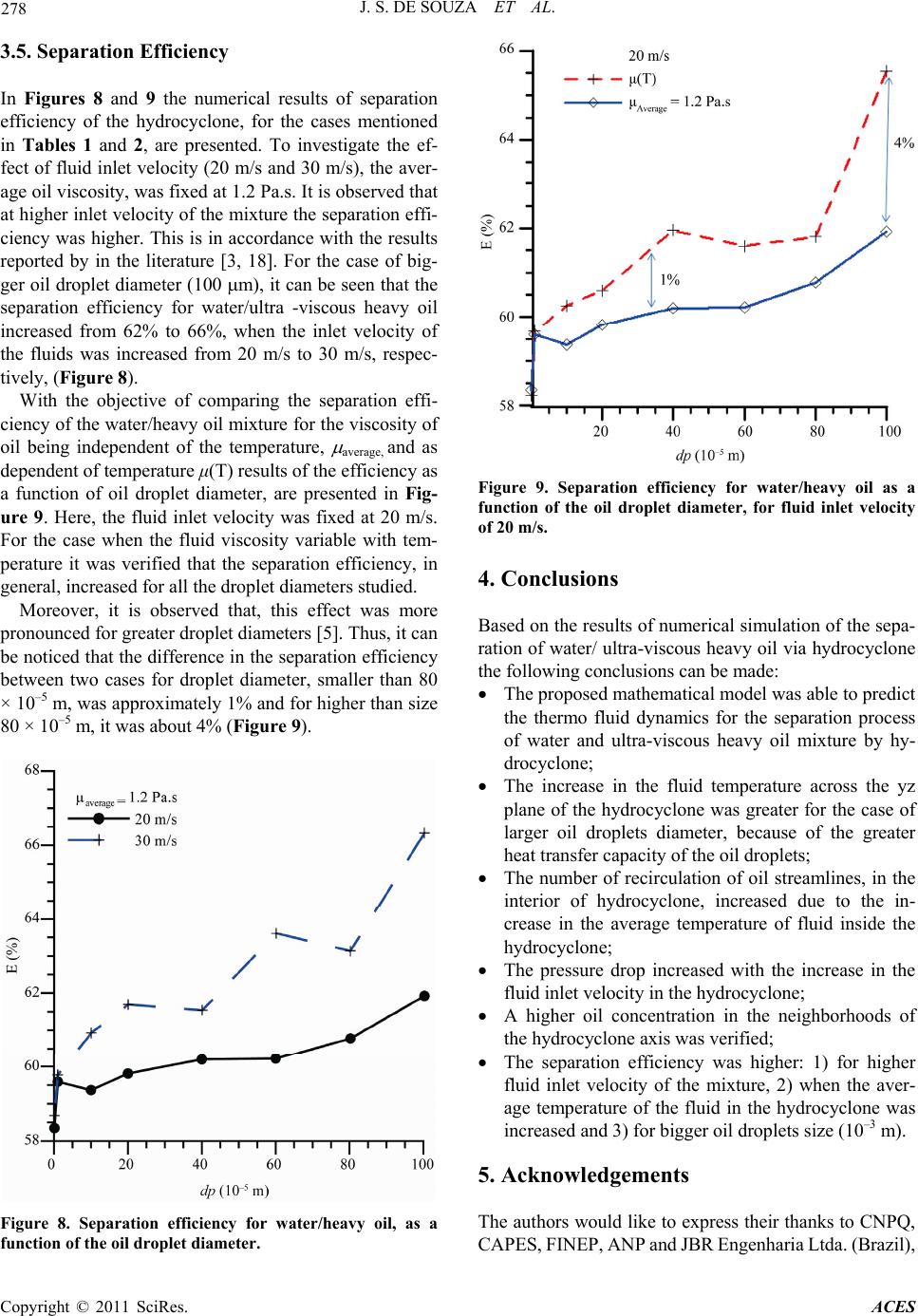 278 J. S. DE SOUZA ET AL. 3.5. Separation Efficiency In Figures 8 and 9 the numerical results of separation efficiency of the hydrocyclone, for the cases mentioned in Tables 1 and 2, are presented. To investigate the ef- fect of fluid inlet velocity (20 m/s and 30 m/s), the aver- age oil viscosity, was fixed at 1.2 Pa.s. It is observed that at higher inlet velocity of the mixture the separation effi- ciency was higher. This is in accordance with the results reported by in the literature [3, 18]. For the case of big- ger oil droplet diameter (100 m), it can be seen that the separation efficiency for water/ultra -viscous heavy oil increased from 62% to 66%, when the inlet velocity of the fluids was increased from 20 m/s to 30 m/s, respec- tively, (Figure 8). With the objective of comparing the separation effi- ciency of the water/heavy oil mixture for the viscosity of oil being independent of the temperature, average, and as dependent of temperature μ(T) results of the efficiency as a function of oil droplet diameter, are presented in Fig- ure 9. Here, the fluid inlet velocity was fixed at 20 m/s. For the case when the fluid viscosity variable with tem- perature it was verified that the separation efficiency, in general, increased for all the droplet diameters studied. Moreover, it is observed that, this effect was more pronounced for greater droplet diameters [5]. Thus, it can be noticed that the difference in the separation efficiency between two cases for droplet diameter, smaller than 80 × 10–5 m, was approximately 1% and for higher than size 80 × 10–5 m, it was about 4% (Figure 9). Figure 8. Separation efficiency for water/heavy oil, as a function of the oil droplet diameter. Figure 9. Separation efficiency for water/heavy oil as a function of the oil droplet diameter, for fluid inlet velocity of 20 m/s. 4. Conclusions Based on the results of numerical simulation of the sepa- ration of water/ ultra-viscous heavy oil via hydrocyclone the following conclusions can be made: The proposed mathematical model was able to predict the thermo fluid dynamics for the separation process of water and ultra-viscous heavy oil mixture by hy- drocyclone; The increase in the fluid temperature across the yz plane of the hydrocyclone was greater for the case of larger oil droplets diameter, because of the greater heat transfer capacity of the oil droplets; The number of recirculation of oil streamlines, in the interior of hydrocyclone, increased due to the in- crease in the average temperature of fluid inside the hydrocyclone; The pressure drop increased with the increase in the fluid inlet velocity in the hydrocyclone; A higher oil concentration in the neighborhoods of the hydrocyclone axis was verified; The separation efficiency was higher: 1) for higher fluid inlet velocity of the mixture, 2) when the aver- age temperature of the fluid in the hydrocyclone was increased and 3) for bigger oil droplets size (10–3 m). 5. Acknowledgements The authors would like to express their thanks to CNPQ, CAPES, FINEP, ANP and JBR Engenharia Ltda. (Brazil), Copyright © 2011 SciRes. ACES 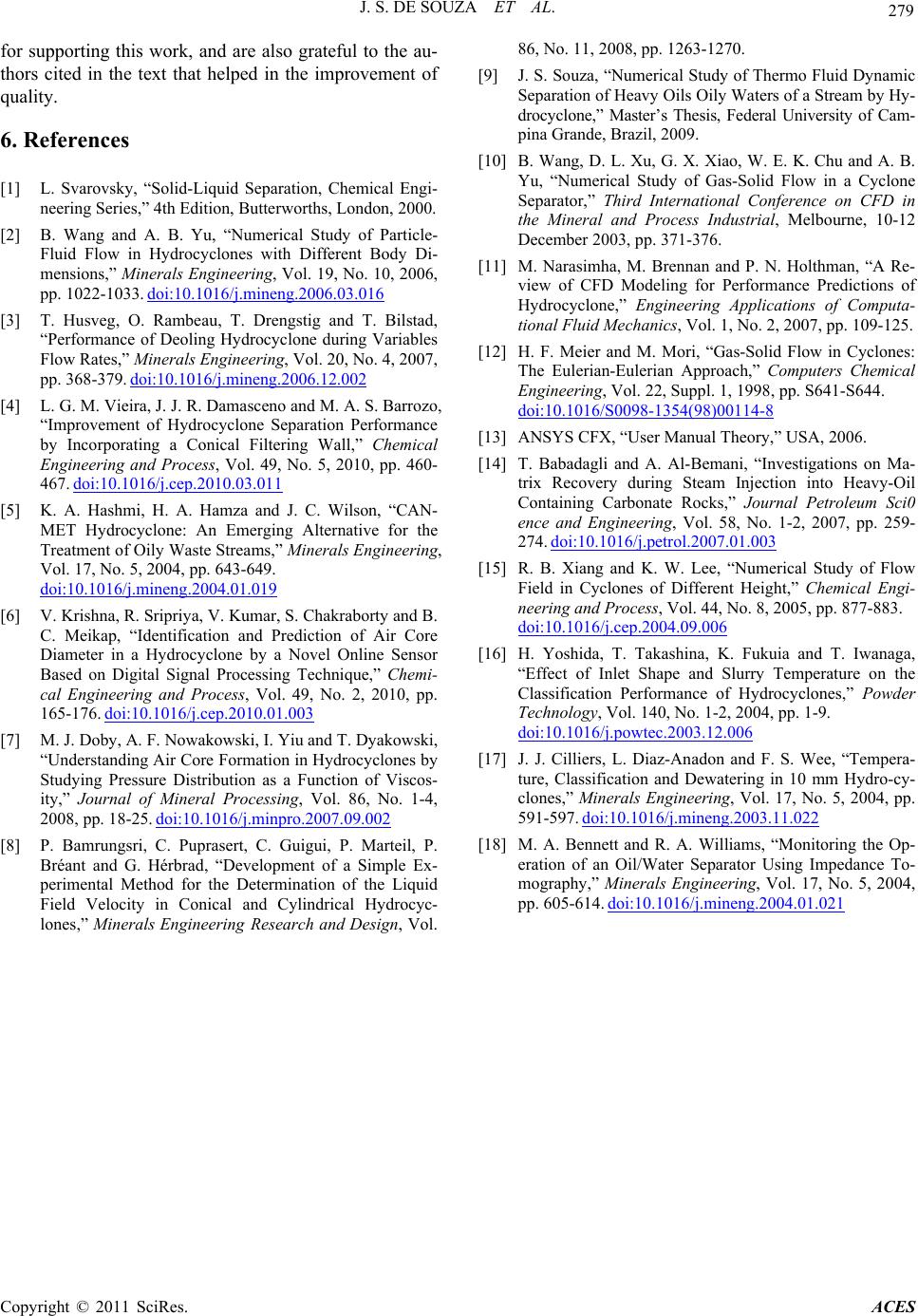 J. S. DE SOUZA ET AL. Copyright © 2011 SciRes. ACES 279 for supporting this work, and are also grateful to the au- thors cited in the text that helped in the improvement of quality. 6. References [1] L. Svarovsky, “Solid-Liquid Separation, Chemical Engi- neering Series,” 4th Edition, Butterworths, London, 2000. [2] B. Wang and A. B. Yu, “Numerical Study of Particle- Fluid Flow in Hydrocyclones with Different Body Di- mensions,” Minerals Engineering, Vol. 19, No. 10, 2006, pp. 1022-1033. doi:10.1016/j.mineng.2006.03.016 [3] T. Husveg, O. Rambeau, T. Drengstig and T. Bilstad, “Performance of Deoling Hydrocyclone during Variables Flow Rates,” Minerals Engineering, Vol. 20, No. 4, 2007, pp. 368-379. doi:10.1016/j.mineng.2006.12.002 [4] L. G. M. Vieira, J. J. R. Damasceno and M. A. S. Barrozo, “Improvement of Hydrocyclone Separation Performance by Incorporating a Conical Filtering Wall,” Chemical Engineering and Process, Vol. 49, No. 5, 2010, pp. 460- 467. doi:10.1016/j.cep.2010.03.011 [5] K. A. Hashmi, H. A. Hamza and J. C. Wilson, “CAN- MET Hydrocyclone: An Emerging Alternative for the Treatment of Oily Waste Streams,” Minerals Engineering, Vol. 17, No. 5, 2004, pp. 643-649. doi:10.1016/j.mineng.2004.01.019 [6] V. Krishna, R. Sripriya, V. Kumar, S. Chakraborty and B. C. Meikap, “Identification and Prediction of Air Core Diameter in a Hydrocyclone by a Novel Online Sensor Based on Digital Signal Processing Technique,” Chemi- cal Engineering and Process, Vol. 49, No. 2, 2010, pp. 165-176. doi:10.1016/j.cep.2010.01.003 [7] M. J. Doby, A. F. Nowakowski, I. Yiu and T. Dyakowski, “Understanding Air Core Formation in Hydrocyclones by Studying Pressure Distribution as a Function of Viscos- ity,” Journal of Mineral Processing, Vol. 86, No. 1-4, 2008, pp. 18-25. doi:10.1016/j.minpro.2007.09.002 [8] P. Bamrungsri, C. Puprasert, C. Guigui, P. Marteil, P. Bréant and G. Hérbrad, “Development of a Simple Ex- perimental Method for the Determination of the Liquid Field Velocity in Conical and Cylindrical Hydrocyc- lones,” Minerals Engineering Research and Design, Vol. 86, No. 11, 2008, pp. 1263-1270. [9] J. S. Souza, “Numerical Study of Thermo Fluid Dynamic Separation of Heavy Oils Oily Waters of a Stream by Hy- drocyclone,” Master’s Thesis, Federal University of Cam- pina Grande, Brazil, 2009. [10] B. Wang, D. L. Xu, G. X. Xiao, W. E. K. Chu and A. B. Yu, “Numerical Study of Gas-Solid Flow in a Cyclone Separator,” Third International Conference on CFD in the Mineral and Process Industrial, Melbourne, 10-12 December 2003, pp. 371-376. [11] M. Narasimha, M. Brennan and P. N. Holthman, “A Re- view of CFD Modeling for Performance Predictions of Hydrocyclone,” Engineering Applications of Computa- tional Fluid Mechanics, Vol. 1, No. 2, 2007, pp. 109-125. [12] H. F. Meier and M. Mori, “Gas-Solid Flow in Cyclones: The Eulerian-Eulerian Approach,” Computers Chemical Engineering, Vol. 22, Suppl. 1, 1998, pp. S641-S644. doi:10.1016/S0098-1354(98)00114-8 [13] ANSYS CFX, “User Manual Theory,” USA, 2006. [14] T. Babadagli and A. Al-Bemani, “Investigations on Ma- trix Recovery during Steam Injection into Heavy-Oil Containing Carbonate Rocks,” Journal Petroleum Sci0 ence and Engineering, Vol. 58, No. 1-2, 2007, pp. 259- 274. doi:10.1016/j.petrol.2007.01.003 [15] R. B. Xiang and K. W. Lee, “Numerical Study of Flow Field in Cyclones of Different Height,” Chemical Engi- neering and Process, Vol. 44, No. 8, 2005, pp. 877-883. doi:10.1016/j.cep.2004.09.006 [16] H. Yoshida, T. Takashina, K. Fukuia and T. Iwanaga, “Effect of Inlet Shape and Slurry Temperature on the Classification Performance of Hydrocyclones,” Powder Technology, Vol. 140, No. 1-2, 2004, pp. 1-9. doi:10.1016/j.powtec.2003.12.006 [17] J. J. Cilliers, L. Diaz-Anadon and F. S. Wee, “Tempera- ture, Classification and Dewatering in 10 mm Hydro-cy- clones,” Minerals Engineering, Vol. 17, No. 5, 2004, pp. 591-597. doi:10.1016/j.mineng.2003.11.022 [18] M. A. Bennett and R. A. Williams, “Monitoring the Op- eration of an Oil/Water Separator Using Impedance To- mography,” Minerals Engineering, Vol. 17, No. 5, 2004, pp. 605-614. doi:10.1016/j.mineng.2004.01.021
|